12W - 17W


Dragon Quest 3 was provided by Square Enix for review. Thank you!
Dragon Quest has evolved over the last 35+ years and has become a staple in the JRPG space. The series has grown since its first release in 1986 and has become increasingly popular. With the most recent mainline game being Dragon Quest 11, Square Enix decided to remake the oldest titles and give them the HD-2D facelift, which we have seen in games like Octopath Traveler, LIVE A LIVE, and Star Ocean The Second Story R.

Now, we get to return to the Erdrick trilogy, starting with the first chronological game in this trilogy: Dragon Quest 3. It's a blast exploring the game in this new light, and while it did bring with it some original JRPG conventions I am not a huge fan of, I still loved the experience and highly recommend it to all JRPG fans.
The entire Erdrick trilogy spans across the first three games in the series, which starts with Dragon Quest 3 chronologically. You are the child of the legendary warrior Ortega, who failed in his attempt to take down the archfiend Baramos. On your 16th birthday, you are summoned to the castle by the King and tasked to kill the archfiend. So, you take up the quest, grab your three companions, and go on your way, traveling across the different lands of this world.
The story of Dragon Quest 3 starts a bit slow, and it can feel like you are going from town to town to get the items you need to complete your mission, which you are. It's a lot of going back and forth, collecting keys or orbs to progress and unlock the doors you need, but that doesn't stop the game from staying interesting. The side quests can be intriguing, and I enjoyed a couple of mainline quests, but the big twist that happens later on is what hooked me in. If it feels a bit slow initially, stick with it. It will be worthwhile.
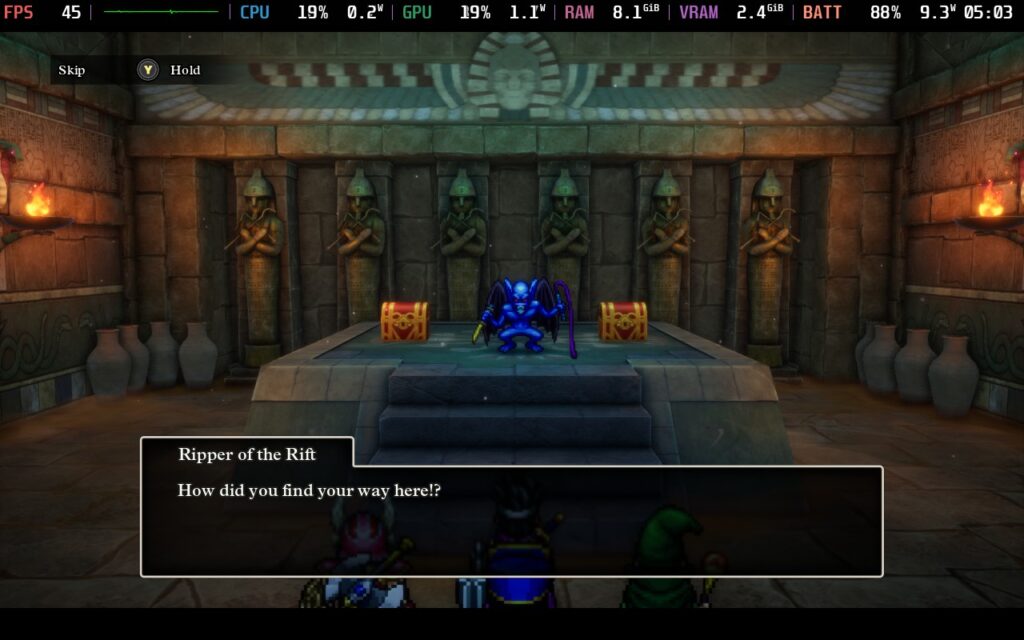
Dragon Quest 3 HD-2D Remake retains what makes the older JRPGs so special, including both the good and bad. There have been a few great quality-of-life changes and some new content that I really enjoyed, but some small nuisances add up.
The game utilizes turn-based combat, allowing you to pick what each member of your four-party team will do and attack them before choosing again. Each character can utilize a regular attack, abilities, or spells/magic to attack, with the latter two consuming magic points or MP. After battles, you will receive experience points to level up your team members and gold, which can be used to buy new items or resurrect your team.
The core combat loop is familiar to other turn-based titles, but some recurring Dragon Quest features are included. You choose each character’s attacks while your Agility stat determines when they will attack exactly. You also target groups of similar enemies instead of individuals (unless there's only one). Some spells and abilities can target only one enemy, all in a group or every enemy you are fighting regardless of group. Still, most attacks will usually be one random enemy in a group or every enemy in that group. This can sometimes be a little obnoxious, but some attacks can circumvent the group attacking, so that’s nice.
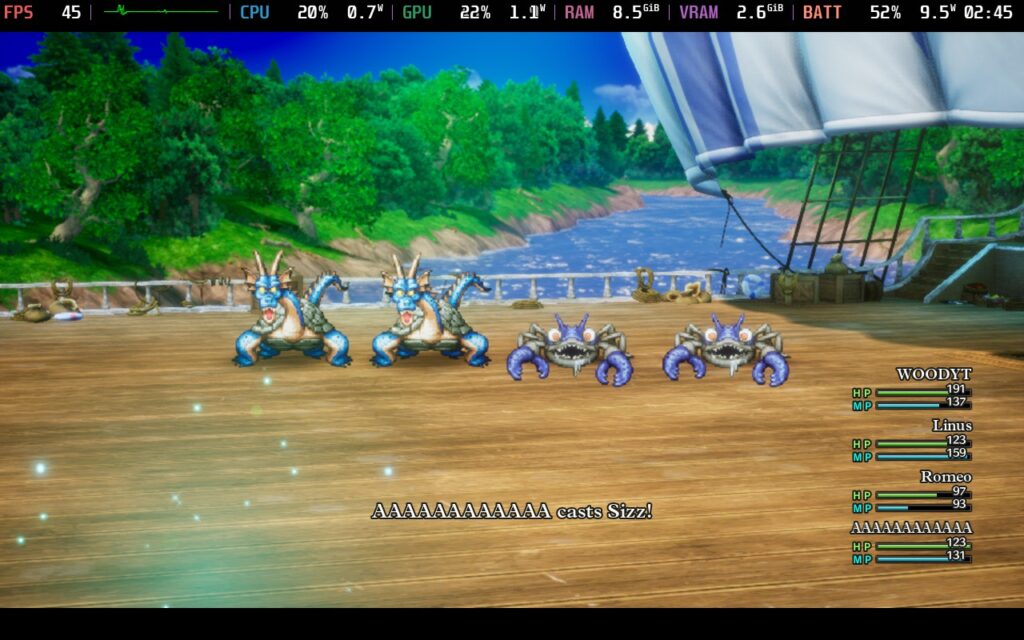
General combat can be a bit slow on normal, and while there are some nice animations to show monsters getting attacked, I felt it was taking way too long the more I played. One of the big new quality-of-life features is the ability to speed up battles, making them go much faster. It will be especially helpful when grinding becomes necessary to get through bosses and dungeons later in the game. You can make each team member act independently and utilize different strategies like going all out on enemies, fighting wisely with a balance of healing and attacking, or not using MP. You can also use this on your “Hero,” automating battles even more. Again, this becomes very nice for late-game grinding and is something I appreciated leading up to tougher battles.
Each character has their class or Vocation, which dictates the stats and new abilities/spells they get through leveling up. As you play, you can change your team member’s vocation. It acts similarly to reincarnating in the Disgaea games. Choosing a new vocation for your team brings their level back down to 1, but their stats are only halved. So, if you have a warrior with 200 strength, you can choose a new vocation like Martial Artist, and they start at level 1 with 100 strength stat. This makes them significantly more powerful than a new Martial Artist at level 1, boosting them as they level back up to where they were before. You also retain all the abilities and spells you learned, which can make your team overpowered if you do the grinding work.
There are multiple vocations, with different focuses, and even some hilarious ones, like the clown. This system was in the original game, but we have the new Monster Tamer vocation that gives us some abilities that other monsters have or allows us to use monsters to attack and heal others. I love these kinds of systems to consistently make my team stronger, and I used them all the time in Disgaea.
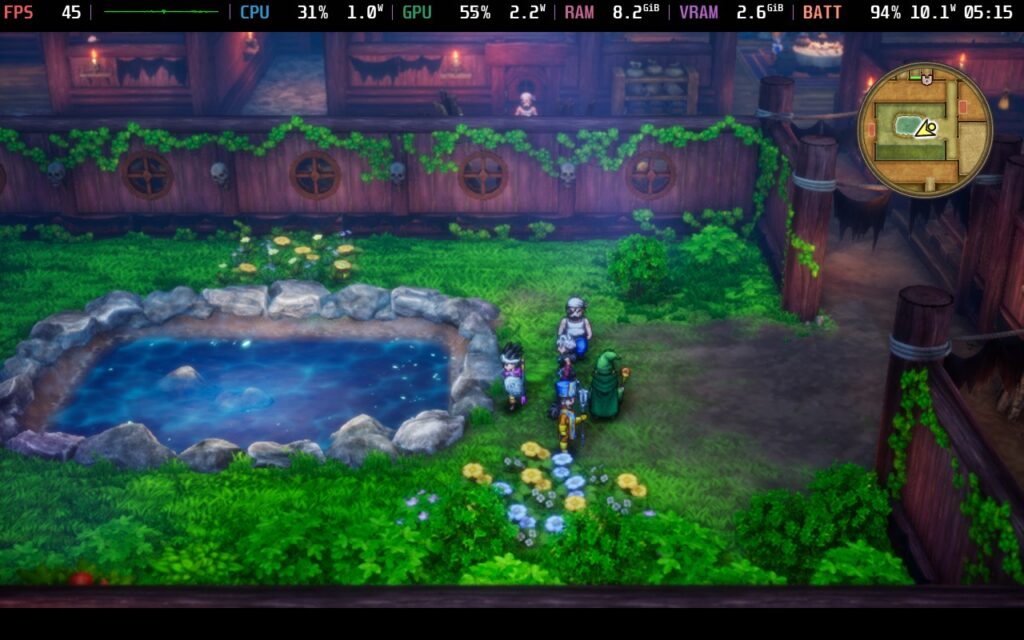
I like how they implemented it here, especially with all the abilities kept. I ended up having a team member who excelled in both physical combat with some devastating combat abilities and magic with spells that could obliterate everyone in front of me. It’s worth the grinding and investment; you can feel the results in real-time. I don’t recommend changing everyone's vocations at a time since they will still be less powerful than before, and you still need to kill enemies to level them back up.
You will travel worldwide in towns/kingdoms or along the world map when not in combat. There are random encounters when walking around, and no indication of when you will be dragged into battle, but I didn’t mind this nearly as much due to how fast and automated battles can be. As you explore, you may find pockets of supplies on the map or hidden in barrels and pots inside towns that include healing items and seeds, which can be used to permanently increase your stats. There may also be hidden areas on the map with some secret items and even some monsters to befriend. You can also use the Monster Tamer vocation to find some monsters.
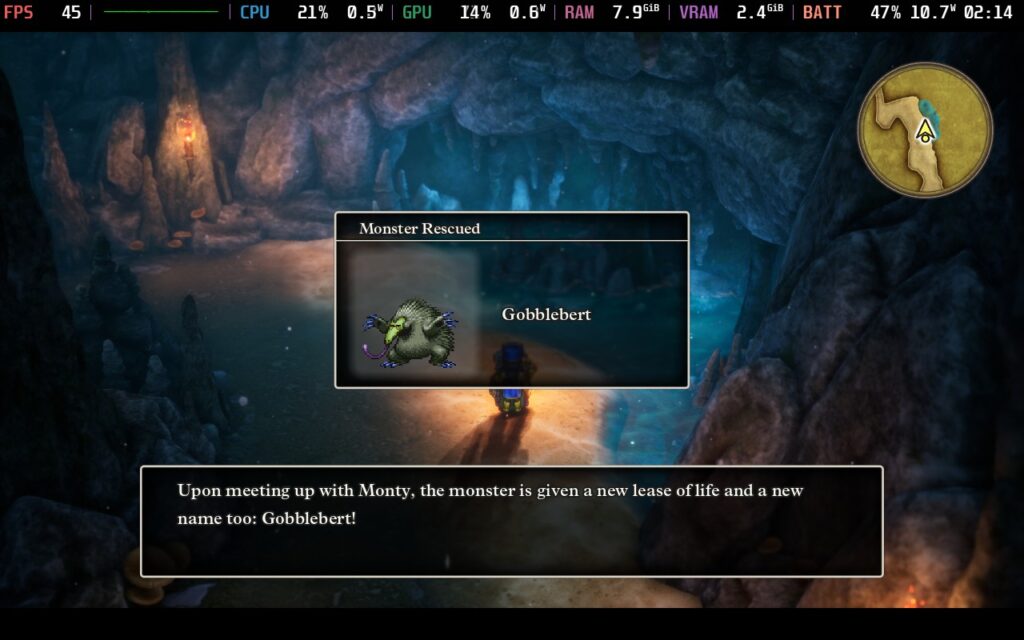
There is a new Monster Arena in the game that allows you to battle the monsters you befriend and win gold and other great prizes. These can be found in most bigger cities, and you choose three monsters to battle for you at a time. There’s also a bank to deposit gold, so you don’t have to store it all on you, which is also a nice little addition. It's an interesting distraction and a nice way to get more equipment, seeds, and healing items to keep your party alive.
Most towns will have inns to sleep at, which heal your health and magic, churches to resurrect your teammates, remove curses, and save your game, and shops to purchase new equipment. The equipment increases stats and can have different effects, like hitting all enemies in the group on a normal attack or returning some damage when attacked. You can use weapons, armor, and accessories to increase your stats, though you may encounter some cursed items that you can't remove until you go to a priest to do it.
The biggest issue with Dragon Quest 3 HD-2D is how long it takes to get through text. I don’t mind the long walks across the map and going through towns to reach my destinations, and I don’t mind that some battles can take some time as well (you can speed this up), but going through some of the text can take way longer than I think it should. Most dialogues are fine, but the after-battle and leveling-up text takes a few seconds before you can move on while saving the game and resurrecting your team, or any action at the church, can take a little longer. With how often I had to save or resurrect my team, sometimes it started to get on my nerves. I appreciate that some spells you can learn and use outside of combat can heal and resurrect, but it takes a little bit of time to get those.
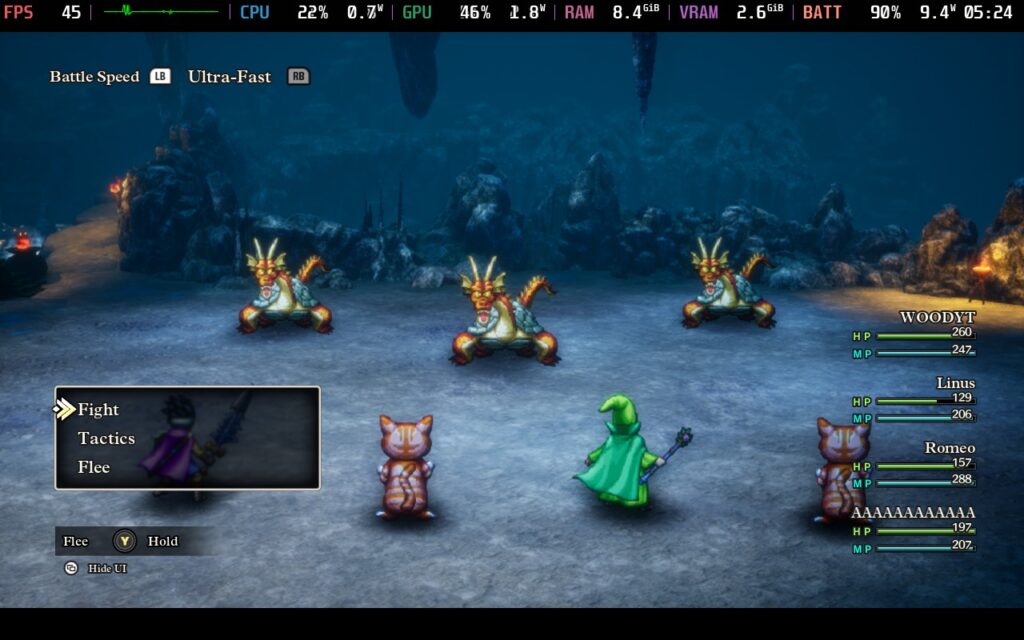
Traveling throughout the world may cause a small headache at first, but as soon as you get the Zoom spell, it gets significantly better. There’s also a lot of grinding that will need to be done to take down the later enemies and more powerful foes, but I didn’t mind this. It feels like an older, unforgiving JRPG, and there’s a charm to that gameplay style. It may frustrate some people, but I like it. There’s a difficulty selection that makes the game a lot easier as well if it gets too much, but even still, you’ll have to grind and get stronger as some enemies will heal, and you can’t get around that.
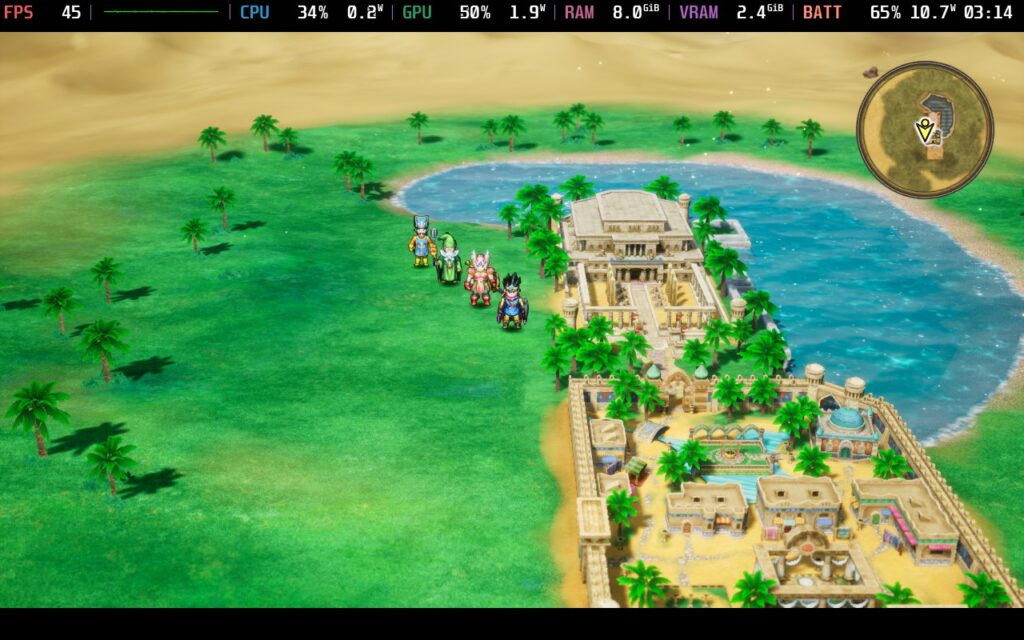
I also appreciate that there is a toggle to turn on an objective marker. It's a pretty big map, and while you can use the clues to find where you need to go, it's nice to turn on a marker to show me where to go next. I still need to grind and fight there, but knowing where I am going is nice.
I don’t know how often I have said this, but I know it has been very often: Square Enix’s HD-2D style is downright gorgeous. The detail of the world around me, the vibrant colors permeating from every angle, and how the 2D sprites navigate all work together seamlessly to create scenes I could print and hang on a wall. The lighting is a big factor here, which I find helps elevate the surroundings more than I expected. It makes everything around just pop out with color and shadows that clearly define the objects they are coming from. Dragon Quest 3 HD-2D is a beauty from start to finish.
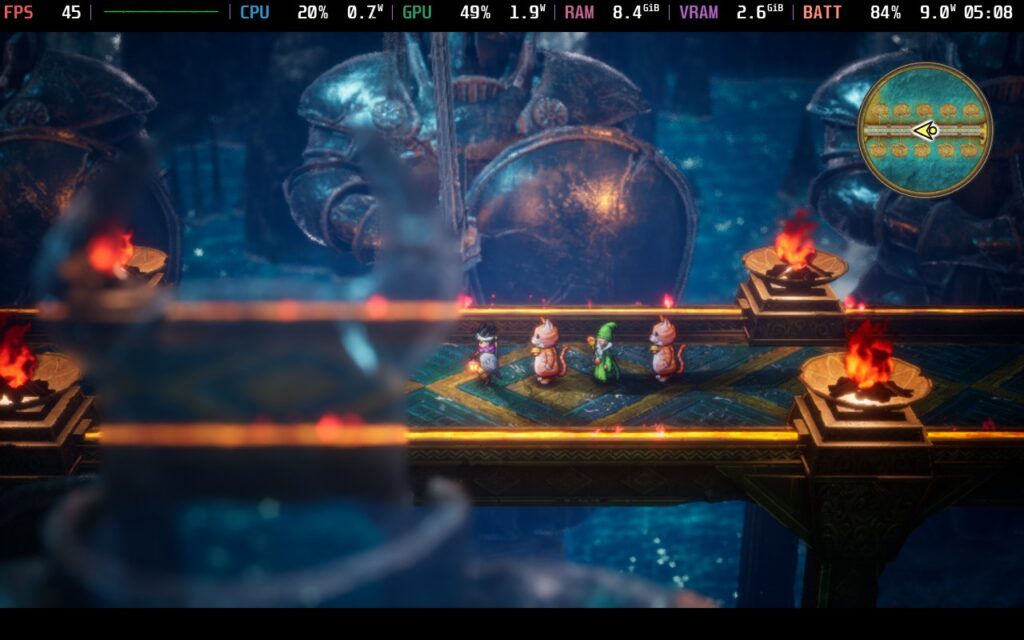
The game has a full day and night cycle, which is nice to see taking place while roaming through the world. The villagers and NPCs will react to the changes, with shops closing and everyone going to bed. Seeing how the world looks and reacts to the cycle is cool. This is packed with a great soundtrack, which feels familiar to those who have played Dragon Quest games.
And playing this game on the Steam Deck will be a blast, even if it needs a change for optimal play.
Dragon Quest 3 HD-2D Remake is a joy to play on the Steam Deck, and in terms of the game's content, it's perfect for portable play. However, I found a couple of little issues that I wanted to change up to make playing on the go a bit better and more stable throughout the game.
I have multiple ways to enjoy the game, but they don't differ much. It isn't an extremely demanding game, so small changes are needed to optimize the experience. Still, I want to provide options for those who want it! Each group of settings prioritizes visuals since I feel that's a very important part of HD-2D games, so keeping them as clear and pristine as possible will be a big focus.
While most of the game runs exceptionally well on the Steam Deck, I found a few smaller issues. There are a couple of areas that do drop the performance below 60 at the default settings (everything maxed out), and there are more areas that have higher battery drain than I would like for a game like this (17W - 21W). However, I wanted to find a way to fix this without compromising the beautiful visuals, so I played around with the settings a bit and found a solution I was happy with.
There are two things I want to change specifically that should make it not only more stable but cap the battery drain at around 16W in the harder-hitting areas. First, we set the framerate cap to 45 FPS. The game still feels wonderfully smooth at this rate, keeping the experience stable. I also recommend bringing down the rendering scale to 2 instead of 3. Not only does this not affect visuals as much on the smaller screen, but it saves a ton of battery. The biggest difference I saw was some slight far-away blurriness and a little more graininess on some surfaces, but these are small, with the rest of the game still looking gorgeous.
I did try turning down other settings, and while reducing Shadows can help, some Shadows will pop in, which I didn't like. I felt like this was a great compromise to keep the game feeling smooth and looking great, as well as lowering the battery drain to save hours of charge so I could continue playing on the go without needing to plug in.
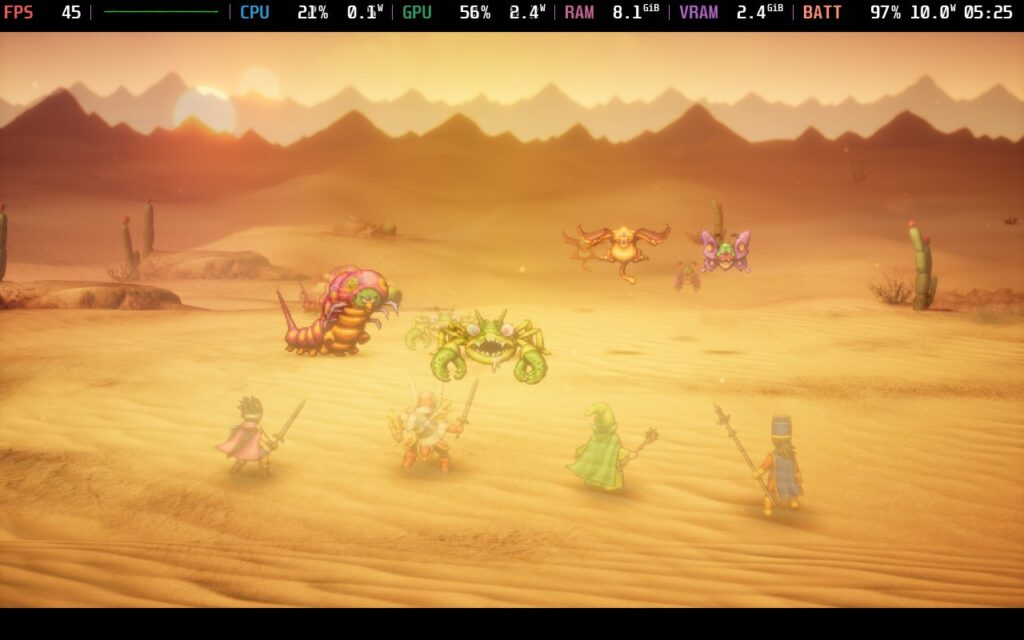
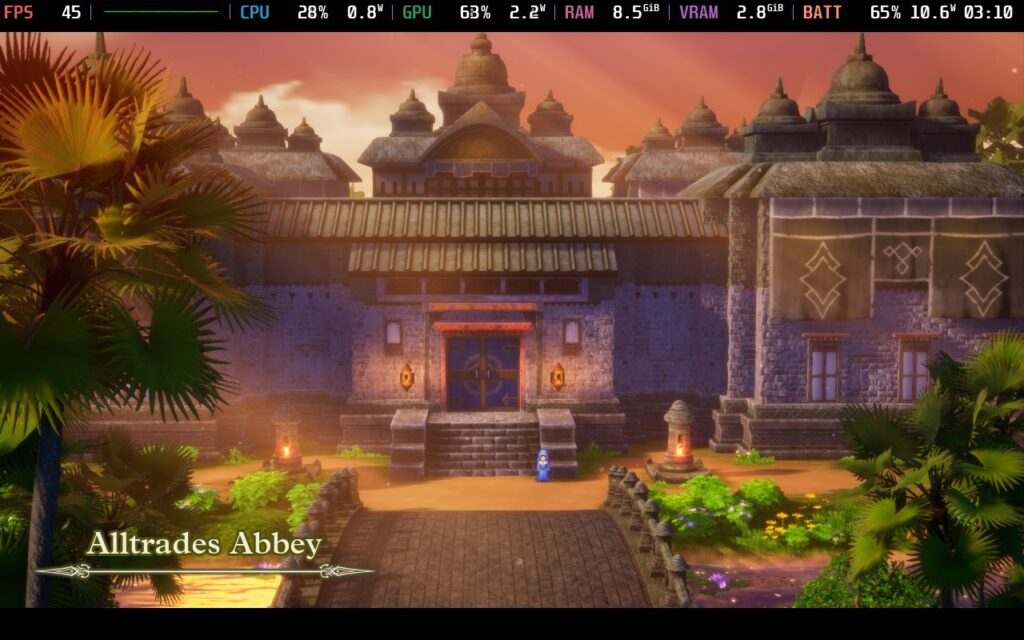
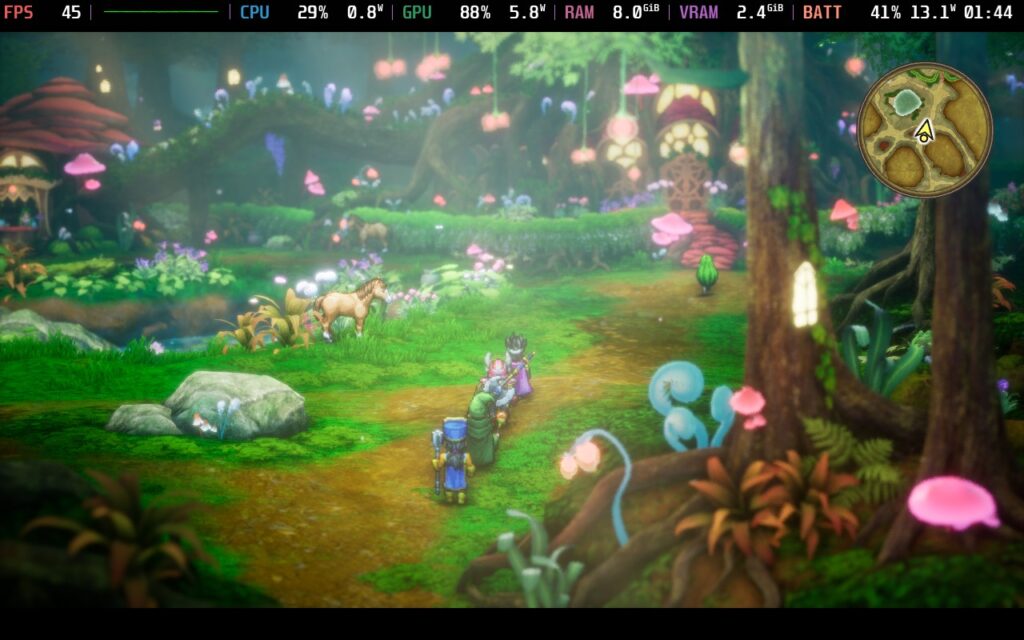
If you don't mind higher battery drain, you could use a 45 FPS lock with max quality settings, and it will stay very stable. It could sometimes bring battery drain above 18W, which I feel is way too high, but it's playable.
Of course, some want to play at 60 FPS as well, and to do so isn't hard! As long as you don't care about battery life, you can use the same Rendering Scale change above to get a solid 60 FPS throughout the entire game. You could keep the settings to their default (max quality), but some areas will drop to the mid-40s. They don't happen super often, but they do happen. I would say the Rendering Scale change is worth it for stability and keeping the visuals as pristine as possible, but if you can deal with minor drops here and there, you can keep the Rendering Scale up.

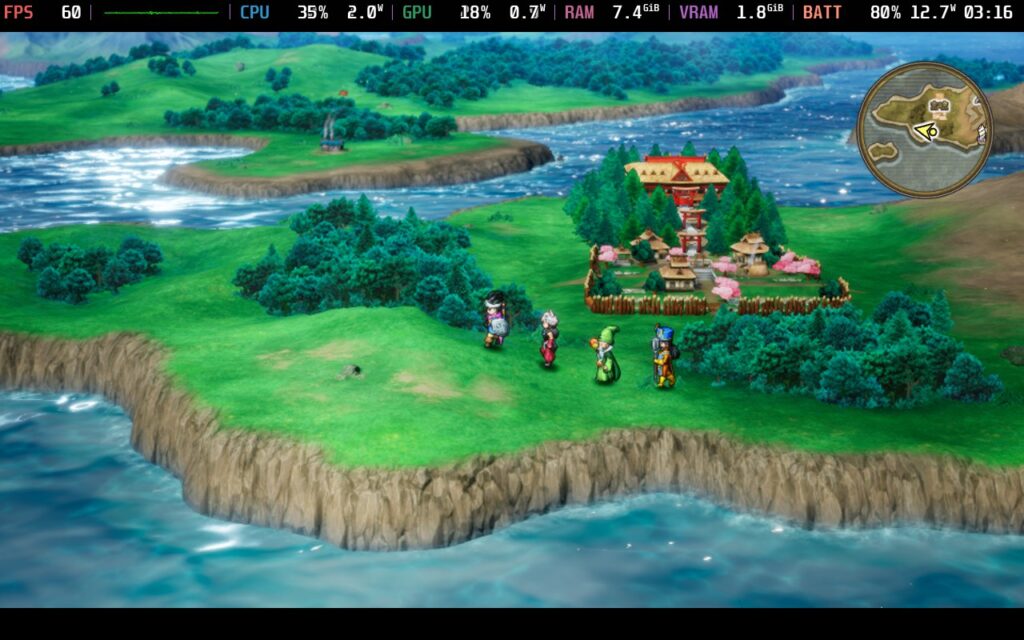
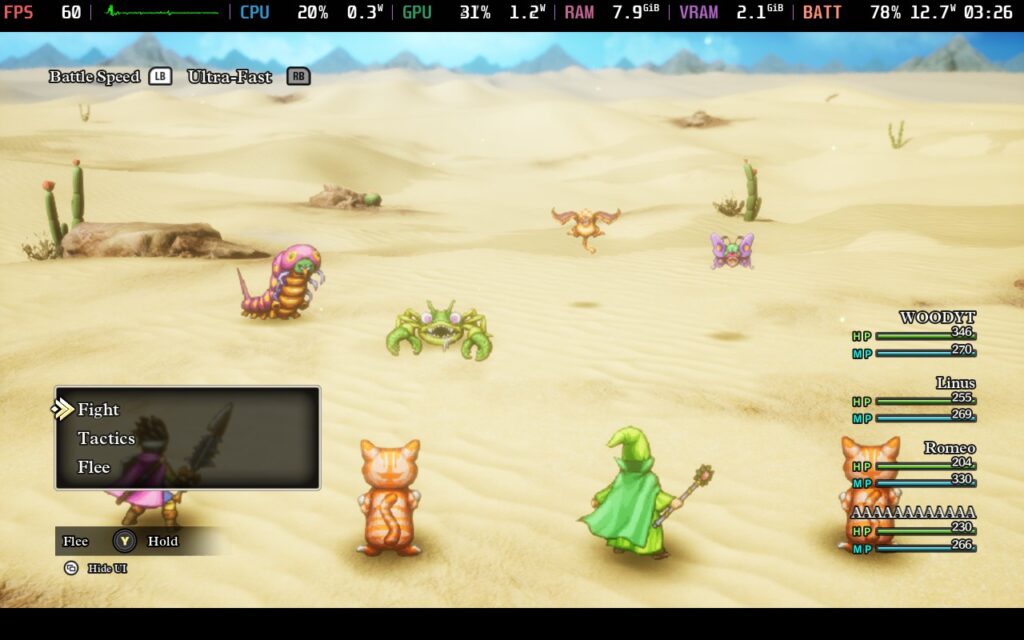
Personally, I think both groups of settings above are great for battery life, but if you want to maximize for portable play, there are a couple of extra changes to make. On top of the Render Scale at 2, I recommended lowering Shadow Quality to 1 and turning Ambient Occlusion off. It does impact visuals a little bit, but not enough to really make a big change to the overall aesthetic and atmosphere:
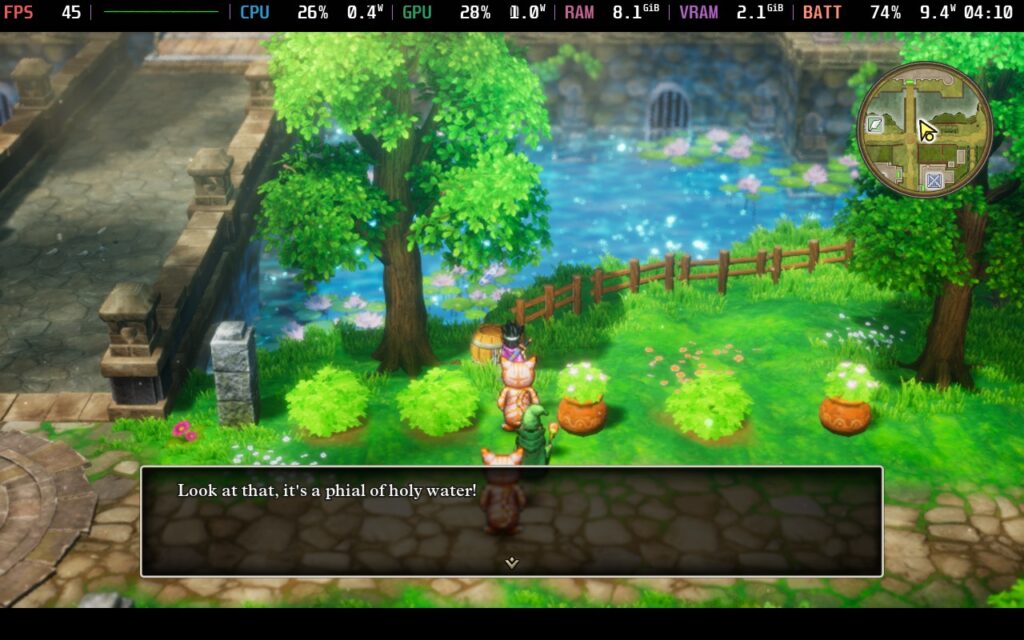
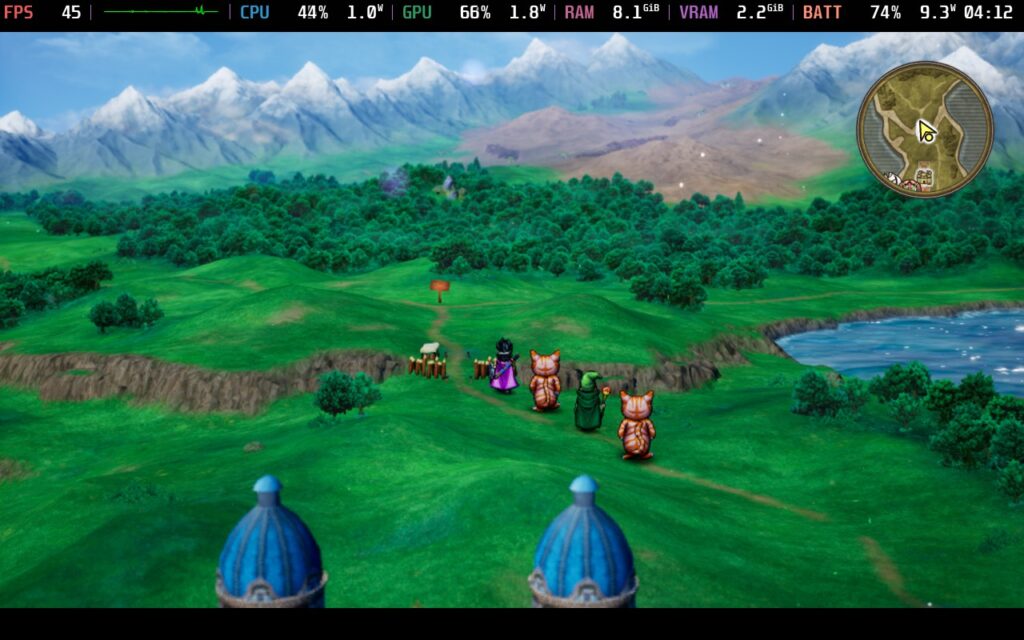
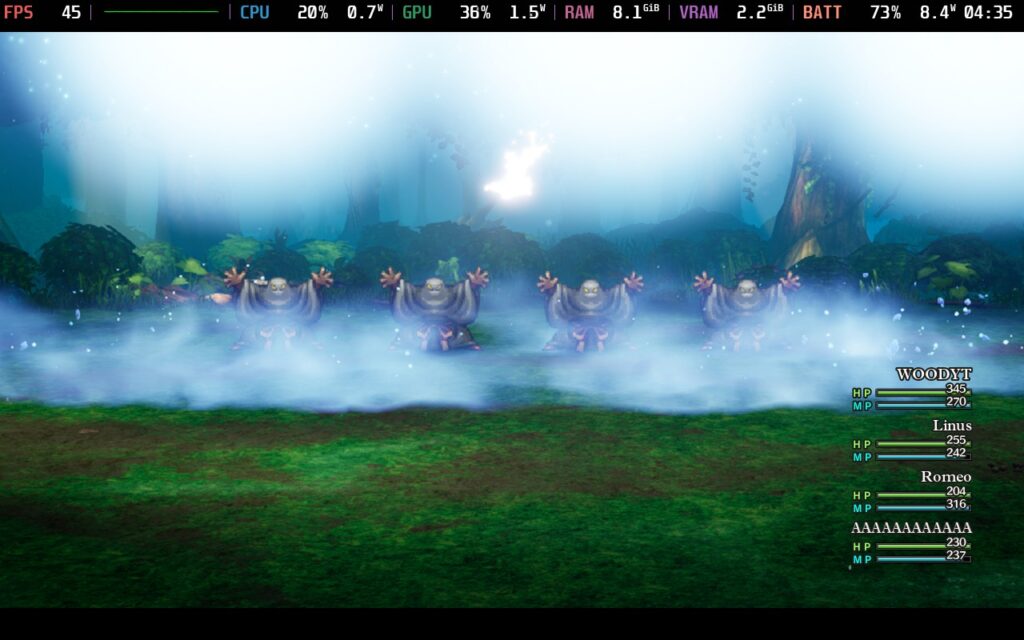
There are some nice settings to go through for Dragon Quest 3. As I mentioned, you can change the battle speed in regular and Monster Arena battles, which I love. You can also change the brightness, toggle the minimap, choose if the camera is a little more zoomed in, audio settings, an objective marker, and quest help text, how fast text is displayed, and whether you have to hold down a button to run, change voice and text language, and whether or not you want to alter the confirm button.
The game doesn't support 16:10 resolutions, so there are some black bars at the top and bottom. However, it supports cloud saves and controllers. There are no HDR settings.
Dragon Quest 3 HD-2D Remake is a fantastic re-imagining of one of the best entries in the Dragon Quest series, even if it misses some quality-of-life improvements I would have loved to see. The game is drop-dead gorgeous and has a solid gameplay loop that I enjoyed. The extra features to speed up battles and automatically let your team fight help with late-game grinding, and the vocation system is a joy to play around with. The new content is also a nice touch, and I particularly enjoyed playing with the new Monster Tamer vocation.
However, there are some little nuisances here and there that I wish were touched on. Some of the text can take a long time to read, with some unnecessary pauses, which is in stark contrast to how fast-paced other parts of the game are, and it ends up feeling like a nuisance. It's small in the grand scheme, but it happens in almost every battle or whenever you need to save, and many other JRPGs go a lot faster when doing something similar.
However, Dragon Quest 3 is a joy to play on the Steam Deck. The small compromises don't hinder the performance and playability of the Steam Deck, and it deserves that Verified badge it has. Regardless of how you play it, whether you want better battery life or 60 FPS, it will be wonderful no matter what.
Our review is based on the PC version of this game.
If you enjoyed this review, be sure to check out the rest of the content on SteamDeckHQ! We have a wide variety of game reviews and news that are sure to help your gaming experience. Whether you're looking for news, tips and tutorials, game settings and reviews, or just want to stay up-to-date on the latest trends, we've got your back.
Dragon Quest 3 HD-2D Remake is a gorgeous and engaging remake while sticking to a lot of older JRPG tropes, for better and worse, and it's a blast on the Steam Deck.

Limit
60
Refresh Rate
60
HRS
NO
TDP Limit
No
Scaling Filter
Linear
GPU Clock
Disabled
No Forced Compatibility
No Changes Needed!
12W - 17W
61c - 66c
3.5 - 4 hours
Limit
45
Refresh Rate
90
HRS
NO
TDP Limit
6
Scaling Filter
Linear
GPU Clock
Disabled
No Forced Compatibility
Everything at 3 Except:
Shadow Quality: 1
Render Scale: 2
Ambient Occlusion: Off
8W - 10W
53c - 57c
5.5 - 6 hours